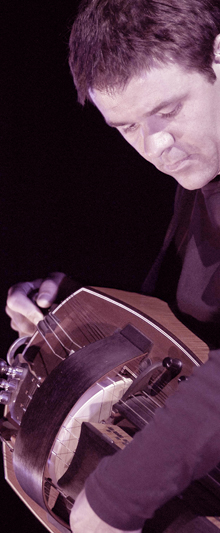 Photo : F. Balestrière |
Chance and curiosity. At the time, it was no longer played by the Thiaulins, the group with whom I began.
At first, I attended Georges Simon’s workshops and I began to really like the hurdy-gurdy thanks to Frédéric Paris . I then worked on André Dubois’ first method, before listening to a lot of Valentin Clastrier.
For several years, I have been playing on hurdy-gurdies made by Denis Siorat. Over the years, Denis has very patiently developed his own aesthetics and instruments which are equally accurate and dependable.
4 chanters: B/C-G- D-G/A (alto)
It is an electro-acoustic instrument, which, for me personally, means mainly a better control of each sound source (chanters, drones, etc.) and thus more nuances and an array of new possibilities: slides, taping, pizzicati, percussion, etc. It also has several capos which can be used either separately or simultaneously.
Steel strings for the drones, synthetic core for the chanters, nylon and gut for the trompettes. With light tirants.
My goal is to achieve the same degree of autonomy with each hand in order to establish a real balance. I have thus worked systematically on dissociating both hands and the various “coups”, 1,2,3,4,5,6,7,8, in an effort to control accurately each fraction of the turn of the wheel in order to eventually achieve complete freedom. But experimentation never stops. I also use the forward/backward movements and staccato technique on the wheel. The other registers (drones and sympathetic strings) may also be used separately, thus unleashing new possibilities.
It seems to me that we now have many different possibilities, whether pedagogical or stylistic. However, one must be careful not to lose sight of the overarching system, in order to avoid confusion or approximation.
Les Écoliers de St Genest, duo with Frédéric Paris, Gabriel Yacoub, I Muvrini , Kepa Junkera (occasionally), Trame (duo with pianist Alain Bonnin), Jean-Marc Padovani, Eric Montbel, Alain Bruel, and many others I have met on the way.
I probably kept on playing the hurdy-gurdy thanks to (or because of) Valentin Clastrier’s first album.
I began with traditional folk music from my area and then tried to create my own tunes. I benefited from the work done in my region (Central France) but also listened to other types of music.
|
||||||